When the world falls apart, medical emergencies won’t wait for society to get back on its feet. Whether it’s a natural disaster, societal collapse, or a full-on apocalypse, having a well-stocked medicinal supply can mean the difference between life and death. If you want to keep yourself and your loved ones safe when hospitals are out of reach, now is the time to prepare. That’s why I’ve taken the time to create a comprehensive list of essential medicinal items to include in your apocalypse stockpile, covering everything from herbal remedies to crucial prescription medications.
Over the Counter (OTC) Essentials for Your Medicinal Stockpile
First up in your medicinal arsenal are common OTC drugs. These are the backbone of your emergency medical kit and should cover a wide range of ailments.
- Pain Relievers: Stock up on both acetaminophen (Tylenol) and ibuprofen (Advil, Motrin). Each has different properties: acetaminophen reduces fever, while ibuprofen is anti-inflammatory. Both can help manage pain and fever during a crisis. Having both options gives you flexibility in treating different types of pain and inflammation, which is crucial when medical assistance is not available.
- Antihistamines: Diphenhydramine (Benadryl) is crucial for allergic reactions, insect bites, and can even help with insomnia. Non-drowsy options like loratadine (Claritin) are also useful for managing seasonal allergies without causing fatigue.
- Anti-Diarrheal Medication: Loperamide (Imodium) is a must for any stockpile. Dehydration from diarrhea can quickly become fatal, especially when clean water is scarce. Keep plenty on hand to prevent a minor illness from becoming a major emergency.
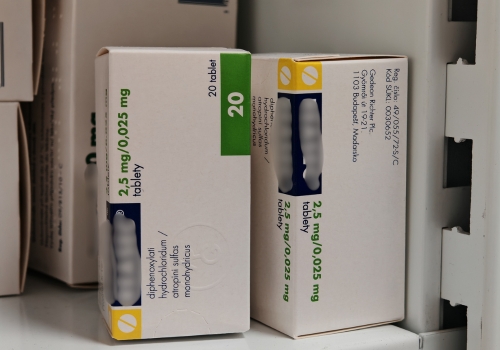
- Antacids: For indigestion and heartburn, stockpile a supply of antacids like Tums or Ranitidine. Digestive issues can be common during times of stress and limited food options, making antacids an essential part of your kit.
- Cold & Flu Remedies: Keep a mix of decongestants, cough suppressants, and fever reducers to help manage the symptoms of respiratory illnesses when modern healthcare isn’t an option. Items like pseudoephedrine (Sudafed) and guaifenesin (Mucinex) can make a significant difference in comfort and recovery.
- Electrolytes: Oral rehydration salts or electrolyte powders can be lifesaving in cases of dehydration caused by illness or extreme conditions. Electrolytes help replenish lost minerals and maintain proper body function when water alone isn’t enough.
Prescription Medications
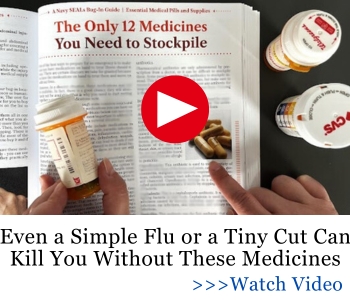 If you or anyone in your family relies on prescription medications, you need a plan to secure these ahead of a crisis.
If you or anyone in your family relies on prescription medications, you need a plan to secure these ahead of a crisis.
- Antibiotics: Infections can turn deadly without treatment. Discuss with your doctor about having antibiotics like amoxicillin or doxycycline for emergencies. Fish antibiotics, available without a prescription, have also become popular as an alternative for emergencies—but use them cautiously and only as a last resort. Understanding dosages and appropriate uses for antibiotics is critical to avoid resistance and complications.
- Chronic Condition Medications: If anyone in your family requires medications for diabetes, blood pressure, or asthma, work with your healthcare provider to stock up on these life-sustaining drugs. Insulin, inhalers, and blood pressure medications are irreplaceable for those who need them, and having a 90-day supply can offer peace of mind.
- Anti-Anxiety and Sleep Aids: In a high-stress situation, staying calm and getting adequate sleep is crucial. Prescription anti-anxiety medication or sedatives like diazepam can be useful, but use them sparingly. Maintaining mental health during a crisis can be just as important as physical health.
Now here’s the problem. Stockpiling prescription medications is tough. Sure, you can try talking to your healthcare provider about getting a larger, extended supply. But there’s no guarantee that this will work – and that’s a risk you just can’t afford when times get rough.
That’s why you need to start thinking about smart, out-of-the-box ways to secure enough prescription meds to keep you going during long-term crises.
There’s a guy down in Texas who figured out a completely ingenious way to get all the insulin he needs – plus extra for tough times ahead. While it’s not something you hear about every day, his method is 100% legal and safe. And the best part? You can start using it right away, not just for insulin, but for many other hard-to-stockpile medications.
➡️ Click here to discover exactly how his method works!
First Aid Supplies
A solid first aid kit is vital for addressing injuries that could otherwise become life-threatening.
- Bandages and Gauze: Keep a variety of sizes, including adhesive bandages, sterile gauze pads, and rolls of gauze for larger wounds. Elastic bandages are also useful for providing support to sprains and stabilizing injuries.
- Antiseptics: Stock alcohol wipes, hydrogen peroxide, or povidone-iodine for cleaning wounds to prevent infection. Keeping wounds clean is one of the most important steps in preventing complications and ensuring proper healing.
- Sterile Gloves: Essential for maintaining hygiene while treating injuries. Gloves help protect both the patient and the caregiver from cross-contamination.
- Tourniquet: In case of severe bleeding, a tourniquet can be life-saving. Make sure you know how to use it properly to avoid causing unnecessary damage.
- Butterfly Strips and Sutures: Butterfly closures are great for closing small wounds, but suture kits or skin glue can be used for more serious cuts—only if you know how to use them. Proper wound closure can prevent infections and promote faster healing.
- Splints and Slings: Keep items like SAM splints or triangular bandages for stabilizing fractures and sprains. Improvising splints can be difficult in a crisis, so having dedicated supplies can save precious time.
- Burn Care Supplies: Stock burn ointments and sterile non-stick dressings to treat burns effectively. Burns can easily become infected, so having the right supplies to care for them is essential.
Herbal Remedies and Natural Alternatives
Modern medications may not always be available. Stocking herbal remedies offers natural alternatives that have been used for centuries.
- Echinacea: Known for its immune-boosting properties, echinacea can help reduce the severity of colds and infections. Keeping it in tincture or capsule form makes it easy to use.
- Ginger: Useful for nausea, stomach upset, and even inflammation. Dried ginger or ginger tea should be a staple. It’s also helpful for motion sickness, which can be an issue in evacuation scenarios.
- Papaya: An excellent natural remedy against stomach parasites. Its seeds contain enzymes that help eliminate worms and improve digestion.
- Garlic: A natural antibiotic, garlic can help ward off infections. Store garlic pills or powdered garlic for easier use. Fresh garlic is also an option, but it has a shorter shelf life.
- Lavender and Peppermint Oils: Lavender is excellent for calming anxiety and promoting sleep, while peppermint oil can relieve headaches and indigestion. Essential oils are versatile and can be used in aromatherapy or applied topically (with dilution).
- Aloe Vera: Great for burns, skin irritations, and minor cuts. Keep aloe vera gel on hand. It’s easy to grow aloe at home, providing a renewable source of this soothing remedy.
- Turmeric: Its anti-inflammatory properties make it useful for treating pain and inflammation naturally. Turmeric can be used in cooking or taken in capsule form, and combining it with black pepper enhances its absorption.
If you have the possibility to grow your own medicinal plants, that’s even better. You wouldn’t need to build up a large stockpile — you’d have constant access to the remedies you need, right from your own backyard. And if you’ve got a garden or even just a small patch of land, you might be surprised how many powerful natural treatments are already growing around you.
 Dr. Nicole Apelian was diagnosed with multiple sclerosis, yet she’s managed to keep it under control for many years — without relying on conventional pharmaceuticals.
Dr. Nicole Apelian was diagnosed with multiple sclerosis, yet she’s managed to keep it under control for many years — without relying on conventional pharmaceuticals.
She now lives a full and active life and has become an inspiration for many folks facing similar health struggles.
In The Forgotten Home Apothecary, Dr. Apelian reveals 250 plant-based remedies for some of the most common ailments you’ll face in everyday life or during a crisis.
You’ll learn exactly which plants to turn to, what they treat, and how to use them effectively — with clear, practical instructions based on real experience and science.
No guesswork. No internet gimmicks. Just proven herbal medicine that actually works — and that you can make at home.
👉 Only Today You’ve Got 78% OFF for The Forgotten Home Apothecary (Get Your Coupon Here)
Tools and Miscellaneous Supplies
To make use of all these supplies, you need the right tools.
- Thermometer: A simple digital thermometer helps monitor fevers, an essential indicator of illness severity. Infrared thermometers are also useful for non-contact temperature checks.
- Scissors and Tweezers: For cutting bandages and removing debris from wounds. High-quality, medical-grade tools are more durable and reliable than household versions.
- Scalpel and Medical Blades: Only if you have the training to use them safely. In a crisis, these can be used for minor surgical procedures, but improper use can be dangerous.
- Blood Pressure Cuff and Stethoscope: For monitoring vital signs, particularly useful for those with chronic health issues. Knowing how to measure blood pressure can help you make informed decisions about care.
- Emergency Blanket: Useful for shock, cold conditions, or any situation where body temperature must be maintained. These lightweight blankets can also be used as makeshift shelters or for signaling.
>> Crucial Tools and Everyday Items to Hunt for at Amish, Army Surplus, and Salvation Army Stores
Stockpiling Tips and Considerations
Stockpiling medications and first aid supplies requires careful planning.
- Expiration Dates: Medications lose potency over time, so keep an inventory and rotate supplies to ensure they are not expired when you need them most. Consider using a spreadsheet or a dedicated notebook to track expiration dates and restocking needs.
- Storage: Store everything in a cool, dry, and dark place. Temperature fluctuations and humidity can degrade the effectiveness of many medications and herbal remedies. Airtight containers and desiccants can help extend the shelf life of sensitive items.
- Training: Knowledge is power. Familiarize yourself with basic first aid and survival medicine. Taking a first aid or CPR course can make all the difference when professional help is unavailable. There are also many online resources and books on wilderness medicine that can provide valuable insights.
- Accessibility: Keep your medical supplies organized and accessible. In a crisis, you won’t have time to dig through clutter—labeling bins or using a checklist can help keep things efficient. Make sure everyone in your household knows where the supplies are and how to use them.
Final Thoughts
A well-stocked medicinal supply isn’t just a convenience—it’s a necessity when the world turns upside down. Preparing for a medical crisis means thinking beyond just first aid and making sure you have what you need to treat a wide range of potential health issues. From painkillers to herbal remedies and first aid tools, every item in your stockpile is a step toward self-reliance and survival.
The time to prepare is now. When the grid goes down, pharmacies run empty, and hospitals shut their doors, you want to be ready to handle any medical emergency that comes your way. Stay safe, stay informed, and make sure your apocalypse medicinal stockpile is ready for whatever the future brings.
Medications are one of the three absolute prepping essentials. The other two? Food and water. Here’s how to stockpile 272 pounds of long-lasting survival food for just $5, and how to use this awesome DIY device that can generate clean water out of thin air (up to 50 gallons per day).
You may also like:
Read This Before Buying Survival Medicine
This is How to Make “Frontier Penicillin” (Video)
20 Medicinal Herbs Every Prepper Must Grow
The 10 Cent Medicine That Every Prepper Should Have In Their Home

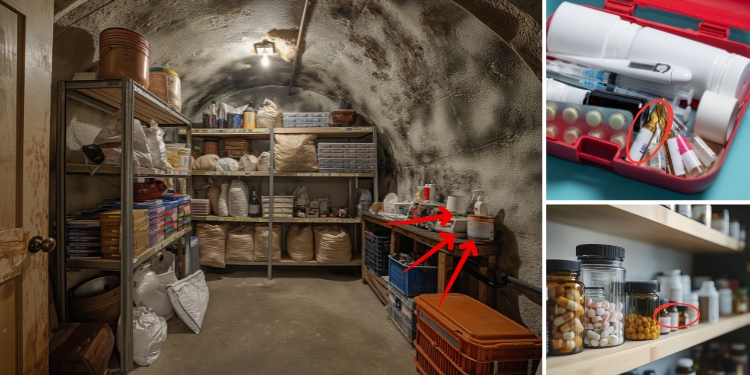
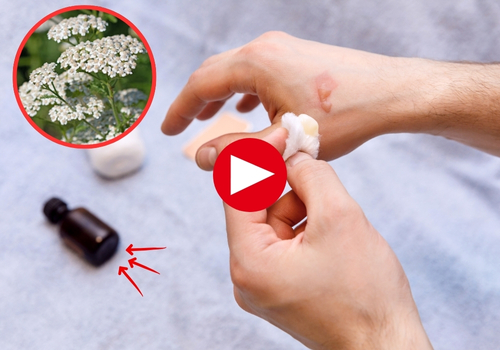








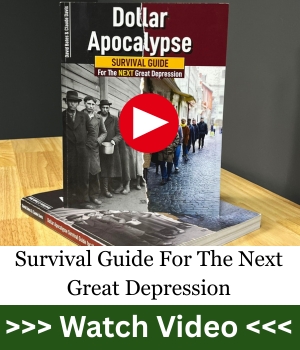












Would it be possible to put a guesstamation on how long meds can be kept past expiration date. And foods canned or dried. That would be fantastic.
The military did a study some years back regarding shelf life of medications. Remember NOT ALL chemicals in medications are the same,and a lot depends on temperature and humidity – but this study is available on-line.
Mary, See my comment below, (or above) LOL!
I know some antibiotics, when taken after the expiration date, will cause kidney failure. The internet says that is the tetracyclines. I’d be wary of any out-of-date antibiotics.
The over-prescribing of antibiotics is harmful, so also when people don’t take the full course that they were prescribed. The latter helps create antibiotic-resistant strains of bacteria, which we absolutely don’t need.
I do know that one thing you don’t want in SHTF at any point is kidney failure.
A lot of other medicines simply lose potency over time. We asked about a relative’s epi-pen expiration date, and the doctor said that after the date that it just wouldn’t be as strong as it used to be, but that it would still work – i.e. better than nothing.
It can be dangerous if we take more because the medicine is weaker and we don’t estimate correctly – like with cardiac meds, pain meds.
Any med that looks or smells bad, I won’t use (similar to food).
Canned foods – if the can is swollen, it has botulism and consumption of even a little bit can be fatal. Cans stored in areas with a lot of thermal cycling i.e. in sunny rooms – will deteriorate faster. Cool and dark places for cans will help them last. If the can isn’t swollen, I would eat foods past the expiration date. The worst thing to happen then will be that the food loses some flavor and a degree of nutritional value.
Dried foods – tend to last much longer than the expiration dates but lose some taste and nutritional value.
I like the recipe in one of the books that they sell here (The Lost Ways?) – it covers (I believe) making pemmican – basically dehydrated meat mixed with tallow. That food is nutritionally complete and will last a very long time, decades upon decades. The story is that 100-year-old pemmican was found in caves in the American Southwest, and it was still edible. Hardtack will also last a long time, but is mainly carbohydrates: flour, salt, water – baked until moisture-free. There’s a video on YT where a guy who eats old military rations and the like tries Civil War-era hardtack. He said it tasted like “mothballs and old library books”. It probably absorbed those smells where it had been stored since the 1800s.
Given the choice between pemmican and hardtack, I’ll take the pemmican.
Wood Stock,
I am not so sure about the Hardtack picking up those flavors in the 1800’s
I mean, isn’t that what fresh Hardtack tastes like ?
Meds, Dan hit it right, DEPENDS, on what Meds and what storage. Woodstock got in there to keep people safe, YES some become deadly, especially antibiotics. We have a fairly new company, jasecase ( Sp ???) but you can find them if you look. If your insurance company gives you the 2 pills extra when you refill, Just keep them coming and build stock, use oldest first. ASK your Dr about YOUR meds – shelf life and tell him/her what if things go bad ? like NO electric for 6 weeks, what then Doc ? ?? they may help you get an extra month or two supply. Insurance wont pay, but you might be surprised at how low cheap some pills are. AND some times a Doc has free samples, just place in rotation and have SOME safe time if SHTF . Ultimately, if you need serious Meds, you need HER book to have a chance – at going years without meds, if you dont know who HER is, you Aint much of a prepper (Apelain)
I think it was the between time in which the CW hardtack absorbed the mothball disagreeableness. Book taste could have been any time. I guess when I have eaten hardtack (made some a few years ago) I just imagined the taste as stale flour. It was not my meal of choice.
Mothballs were officially invented in 1948.
Like baking soda, hardtack will absorb odors. Don’t keep it in your bathroom or you’ll be like the guy who decided to brush his teeth with baking soda that was open in the bathroom. He reported that the taste was awful, tasted like bathroom smells smell.
Yuck.
I enjoy reading these helpful articles. However, I often want to print a copy out and there are so many pictures with dark coloring, which take up a lot of toner. Consequently, it is expensive to make a copy for my files. Could you offer a printed copy without the pictures? Thank you.
Hello, right above the featured image (the first big image in the article) you have 3 buttons. One of them is Printer Friendly, the one in the middle. Just click on that, a new window will appear and you can remove the images to then print.
For my prescription meds, I only get the amount that the prescriber decides, nothing more. I don’t see how anyone could stock up on prescription meds.
A great way to have extra meds. Most insurance companies (all the ones I have used) allow refills a little early some up to 7 days on a 30 day script. This includes Diabetes meds. Easy and legal.
It may be a good idea to look in to these things.
I am sure the Amish know a lot a bout this stuff.
Its most likely a every day use for them.
That,s the good news here.
Now the bad news.
Putin is not giving in to peace,
Trump has had enough .
It look like we will defending Ukraine .
And I worry what Putin will do knowing this.
I will not say it here but some people are thinking what I am.
Its not looking good for the long haul.
It could get really bad for our country if Putin
sees that he is losing this war.
Its says that once President Trump got off the phone with
Putin,
Putin launched more attack,s on Ukraine…
Long term. It could get out of hand.
We can only pray it dose not.
and there is some sort of peace deal.
If it happens,
Only Trump can do this.
bring both sides to the table.
or this may not have a good out come for the world.
Trump has been trying but Putin is not coming to the table.
God help us